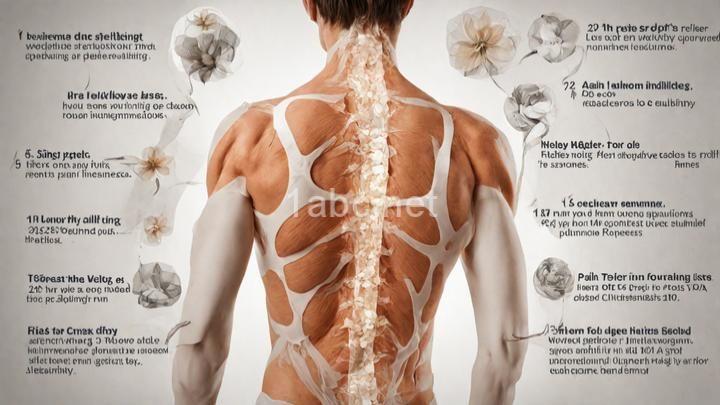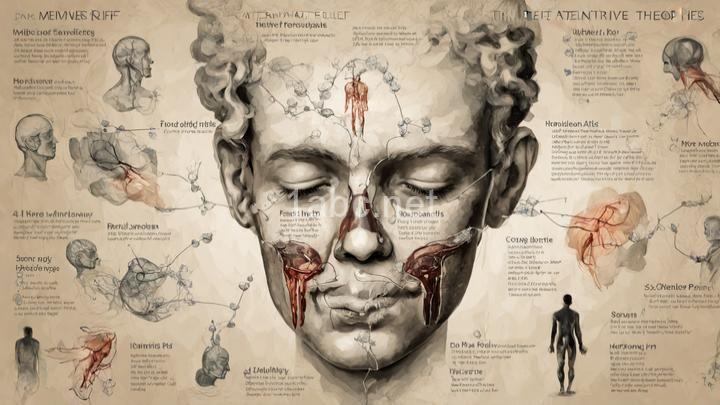Holistic Approaches to Pain Relief: Exploring Alternative Solutions

Introduction:
Do you find yourself constantly reaching for over-the-counter painkillers to alleviate your discomfort? Are you tired of relying on medications that only provide temporary relief? If so, you're not alone. Many people are seeking alternative solutions for pain relief that not only address the symptoms but also promote overall well-being. In this blog, we will explore the concept of holistic approaches to pain relief and discuss various techniques and remedies that can help you find long-lasting relief. So, let's dive in and discover a more holistic path to a pain-free life.
I. Understanding Holistic Approaches to Pain Relief
When it comes to pain relief, holistic approaches take a different perspective. Rather than just focusing on the symptoms, holistic approaches aim to treat the whole person - mind, body, and spirit. These approaches recognize that pain is not solely physical but can also be influenced by emotional and mental factors. By addressing all aspects of a person's well-being, holistic approaches provide a more comprehensive solution to pain management.
One of the key benefits of holistic approaches is their focus on promoting overall well-being. By addressing the underlying causes of pain and considering the individual as a whole, these approaches can lead to long-term improvements in both physical and mental health. It's important to note that while holistic approaches may not completely eliminate pain, they can significantly reduce its impact on daily life and improve overall quality of life.
II. Mind-Body Therapies
A. Meditation and Mindfulness
Meditation and mindfulness practices have gained popularity in recent years for their ability to promote relaxation, reduce stress, and manage pain. By training the mind to focus on the present moment, these practices can help individuals develop a greater awareness of their body and its sensations, allowing them to better cope with pain.
Getting started with meditation or mindfulness can be as simple as finding a quiet place, closing your eyes, and focusing on your breath. Taking just a few minutes each day to practice these techniques can have a profound impact on your pain management journey. Research studies have shown that regular meditation and mindfulness practice can reduce pain intensity and improve overall well-being.
B. Yoga and Tai Chi
Yoga and tai chi are ancient practices that combine physical movement, flexibility, and relaxation techniques to promote overall well-being. These practices are particularly effective in alleviating pain by improving circulation, reducing muscle tension, and increasing flexibility.
Whether you're a beginner or an experienced practitioner, there are various types of yoga and tai chi practices suitable for all fitness levels. From gentle restorative yoga to more dynamic vinyasa flow, you can find a practice that suits your needs and preferences. Numerous studies have shown the positive impact of yoga and tai chi on pain management, with many individuals reporting significant reductions in pain and improved physical functioning.
III. Natural Remedies
A. Herbal Medicine
Herbal medicine has been used for centuries to alleviate pain and promote healing. Some popular herbal remedies known for their pain-relieving properties include turmeric, ginger, and willow bark. These herbs contain natural compounds that have anti-inflammatory and analgesic effects, making them a great alternative to conventional pain medications.
While herbal remedies can be effective, it's important to be aware of any potential precautions or interactions with medications. It's always best to consult with a healthcare professional or a qualified herbalist before incorporating herbal remedies into your routine. They can provide guidance on the appropriate dosage and ensure that there are no contraindications with any existing medications you may be taking.
B. Essential Oils
Essential oils have gained popularity in recent years for their wide range of health benefits, including pain relief. Lavender, peppermint, and eucalyptus are some commonly used essential oils known for their analgesic and anti-inflammatory properties. These oils can be used topically, inhaled, or added to a bath to help alleviate pain and promote relaxation.
When using essential oils, it's important to use them safely and effectively. Essential oils are highly concentrated and should be diluted before applying them to the skin. Additionally, some essential oils may not be suitable for certain individuals, such as pregnant women or those with sensitive skin. It's always best to do your research or consult with a qualified aromatherapist before using essential oils for pain relief.
IV. Physical Therapies
A. Acupuncture
Acupuncture is an ancient Chinese therapy that involves stimulating specific points on the body with thin needles to alleviate pain and promote healing. This practice is based on the belief that energy, known as Qi, flows through the body along pathways called meridians. By inserting needles into specific points along these meridians, acupuncture can help restore the balance of energy and relieve pain.
Numerous studies have shown the effectiveness of acupuncture in managing various types of pain, including chronic pain conditions. Many individuals have reported significant pain reduction and improved quality of life after undergoing acupuncture treatments. However, it's important to address common concerns or misconceptions about acupuncture, such as the fear of needles or potential discomfort. Acupuncture is generally a safe and well-tolerated therapy when performed by a licensed and qualified practitioner.
B. Chiropractic Care
Chiropractic care focuses on the diagnosis and treatment of musculoskeletal disorders, particularly those related to the spine. Chiropractors use manual adjustments and other techniques to realign the spine, improve nerve function, and alleviate pain. This hands-on approach can be particularly beneficial for individuals with back pain, neck pain, and other musculoskeletal conditions.
Chiropractic care has been shown to be effective in reducing pain, improving mobility, and enhancing overall well-being. Many individuals have found relief from chronic pain conditions through regular chiropractic treatments. However, it's important to note that chiropractic care may not be suitable for everyone, particularly those with certain medical conditions or injuries. Always consult with a qualified chiropractor to determine if this therapy is appropriate for your specific needs.
V. Lifestyle Changes
While alternative therapies can provide significant relief, it's important to remember that pain management is a holistic journey that involves making positive lifestyle changes. Diet, exercise, and stress management play a crucial role in overall well-being and can greatly contribute to pain relief.
A healthy and balanced diet can help reduce inflammation in the body, which is often associated with chronic pain conditions. Incorporate anti-inflammatory foods such as fruits, vegetables, whole grains, and healthy fats into your daily meals. Regular exercise, even gentle activities like walking or swimming, can improve circulation, strengthen muscles, and release endorphins, which are natural pain relievers. Lastly, stress management techniques such as deep breathing exercises, journaling, or engaging in hobbies can help reduce stress levels and improve your ability to cope with pain.
It's important to seek professional guidance when making significant lifestyle changes. Healthcare professionals, nutritionists, and therapists can provide personalized advice and support to help you adopt a healthier lifestyle that suits your specific needs.
Conclusion:
In conclusion, holistic approaches to pain relief offer a comprehensive and effective way to manage pain and promote overall well-being. By considering the mind, body, and spirit, these approaches address the root causes of pain and provide long-lasting relief. Whether through mind-body therapies, natural remedies, physical therapies, or lifestyle changes, there are a wide range of holistic options available to help you on your pain management journey. Remember to consult with healthcare professionals or qualified practitioners to determine the best approach for your specific needs. Embrace the power of holistic approaches and pave the way for a pain-free and fulfilling life.
FREQUENTLY ASKED QUESTIONS
What are some alternative solutions for pain relief?
There are several alternative solutions for pain relief that can be used in addition to, or instead of, traditional pain medications. Some of these options include:
Acupuncture: This ancient Chinese therapy involves inserting thin needles into specific points on the body to stimulate pain relief and promote healing.
Massage therapy: Massage can help relax muscles, improve blood flow, and reduce pain. Different techniques, such as Swedish massage, deep tissue massage, or trigger point therapy, may be used depending on the type of pain.
Herbal and natural remedies: Various herbs and natural supplements, such as turmeric, ginger, and Boswellia extract, have anti-inflammatory properties and are thought to help reduce pain and inflammation.
Mind-body techniques: Practices like yoga, meditation, and deep breathing exercises can help reduce stress, improve relaxation, and manage pain.
Heat and cold therapy: Applying heat or cold to a painful area can help alleviate discomfort. Hot packs or warm baths are commonly used for muscle pain, while cold packs or ice are often recommended for managing acute injuries.
TENS units: Transcutaneous Electrical Nerve Stimulation (TENS) devices deliver low-voltage electrical currents, which can help relieve pain by interfering with the pain signals sent to the brain.
It's important to consult with a healthcare professional or pain specialist before trying alternative pain relief methods, to ensure they are suitable for your specific condition and won't interfere with any existing treatments.
Are holistic approaches effective for pain relief?
Holistic approaches can be effective for pain relief, as they focus on treating the whole person rather than just the specific symptoms. Some examples of holistic approaches for pain relief include acupuncture, massage therapy, chiropractic care, yoga, and meditation. These approaches often aim to address the root causes of the pain, such as physical imbalances, emotional stress, or lifestyle factors. However, it is important to note that individual results may vary, and it is always advisable to consult with a healthcare professional before starting any new treatment or approach for pain relief.
Can holistic approaches be used alongside conventional treatments?
Yes, holistic approaches can often be used alongside conventional treatments. Holistic medicine focuses on treating the whole person, including their physical, mental, and emotional well-being. It often involves complementary therapies such as acupuncture, herbal remedies, meditation, and yoga. Many people find that combining these holistic treatments with conventional medicine can lead to better overall health outcomes. However, it is important to consult with healthcare professionals before incorporating holistic approaches to ensure they are appropriate and safe in conjunction with your specific conventional treatments.
How long does it take to see results with holistic pain relief?
The time it takes to see results with holistic pain relief can vary depending on several factors, including the type and severity of the pain, the individual's overall health, and the specific holistic approach being used.
In some cases, people may experience immediate relief from certain holistic treatments such as acupuncture or aromatherapy. However, for chronic or more complex pain conditions, it may take longer to achieve noticeable results.
It's also important to note that holistic pain relief usually involves a combination of different approaches, such as dietary changes, exercise, stress management techniques, and herbal remedies. These approaches may take time to produce a cumulative effect, with gradual improvement over weeks or months.
It's recommended to consult with a qualified healthcare professional or holistic practitioner who can provide personalized guidance on the expected timeframe for seeing results based on your specific situation.

